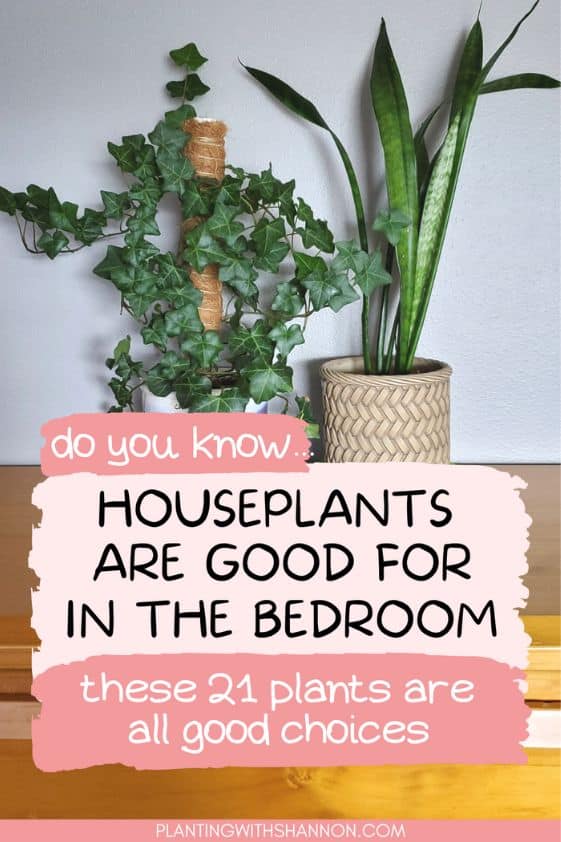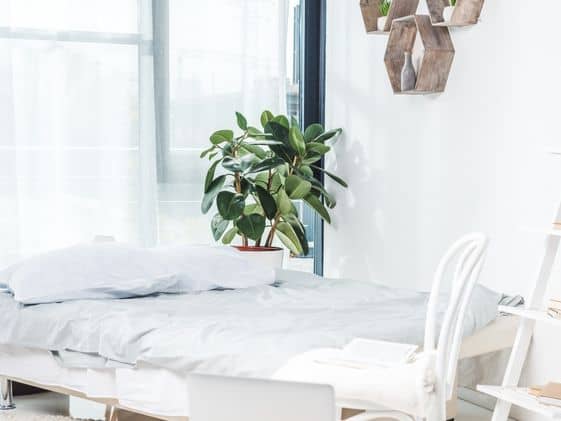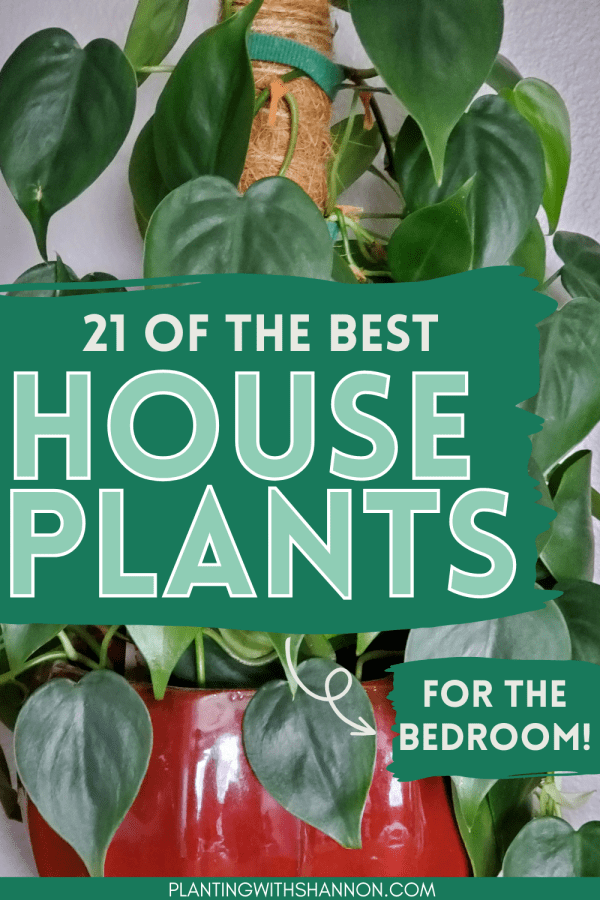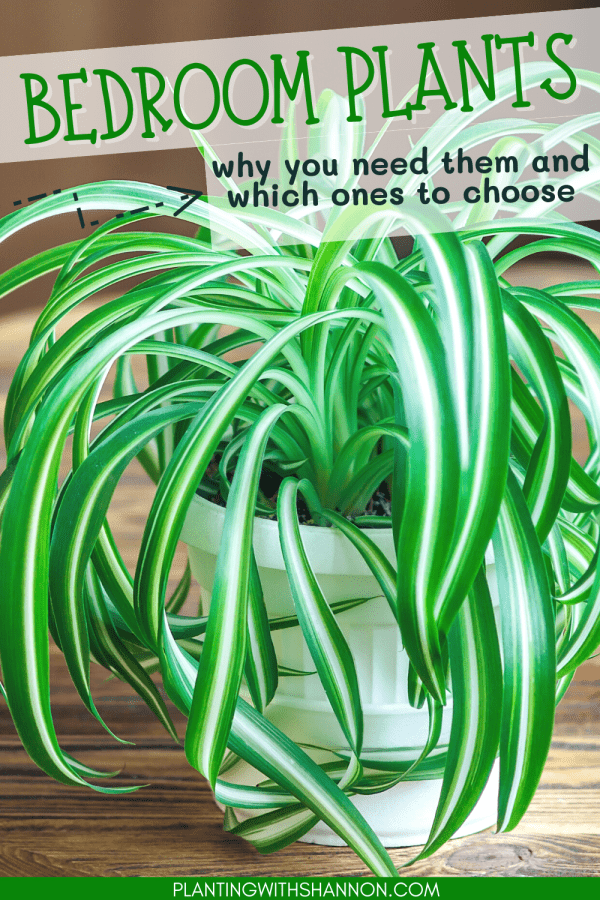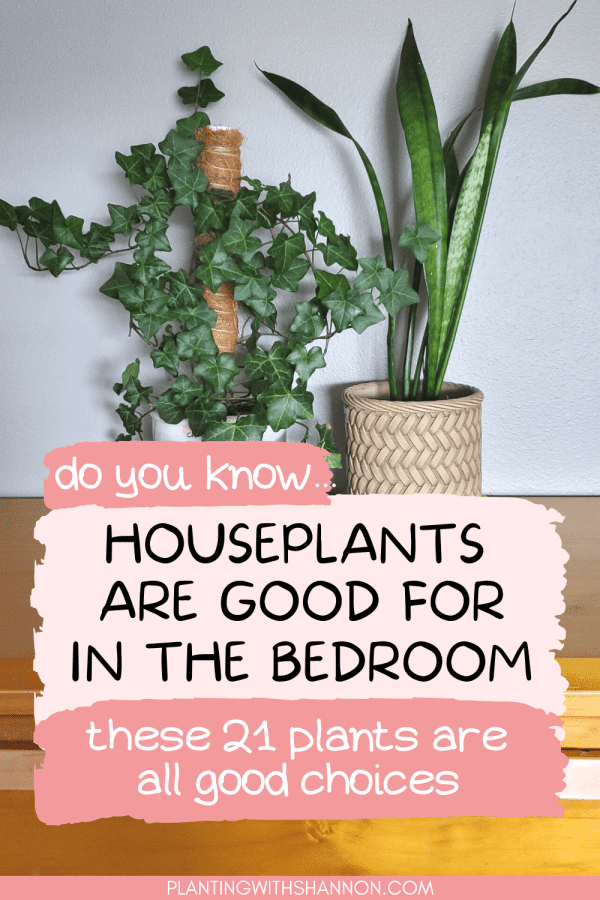Most people know that plants are good for you, but they don’t think to add plants to their bedroom.
Did you know that adding plants to your bedroom might improve your sleep and overall health?
And even if they don’t help you sleep, they can help improve your indoor air quality. NASA did a study and found that houseplants can remove VOCs (volatile organic compounds), such as formaldehyde, benzene, and trichloroethylene, from the air.
Between the possibility of a better night’s sleep and improving air quality, adding plants to your bedroom is a no-brainer.
Read on to see my list of plants for the bedroom and pick the ones that will work for you.
This post may contain affiliate links. That means if you click on them and buy something, I may receive a small commission. Read my Disclaimer Policy to learn more. As an Amazon Associate, I earn from qualifying purchases.
Best bedroom plants
There is a wide range of plants that make great bedroom plants. Here are my top 21 plants to have in the bedroom.
Snake Plant (Sansevieria trifasciata)

Snake plants, also called mother-in-law’s tongue, are relatively easy to care for. They can tolerate many lighting conditions, though they do best in bright, indirect light.
Snake plants produce oxygen at night and remove several toxins from the air including benzene, formaldehyde, and trichloroethylene.
This plant is considered toxic to cats, dogs, and humans.
English Ivy (Hedera helix)
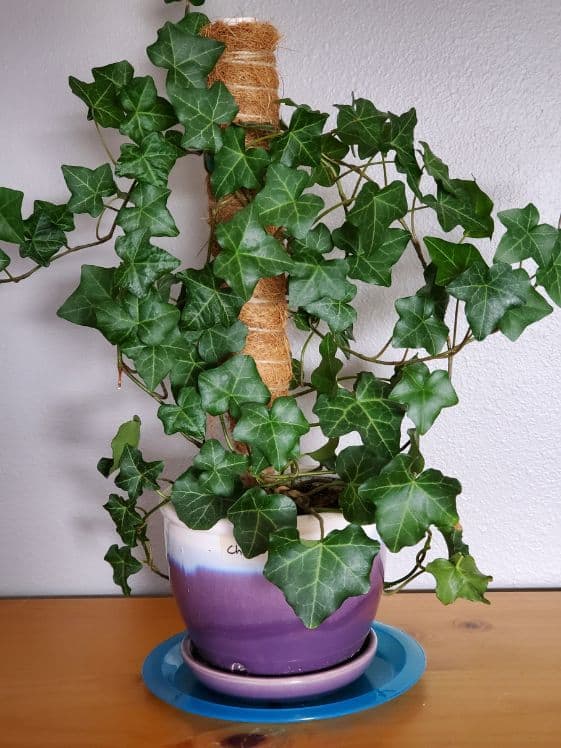
English Ivy is another easy-to-grow plant and can grow in moderate light. This one also cleans benzene, formaldehyde, and trichloroethylene from the air.
English Ivy is a vining plant, so it would look great as a hanging basket.
It is also considered toxic to cats, dogs, and humans.
Aloe Vera (Aloe barbadensis miller)

The aloe vera plant is an easy-to-grow plant that prefers moderate to bright, indirect light. It does not do well in low-light conditions.
They are a little picky on their soil conditions, not liking soggy or too dry of soil.
Aloe is considered a succulent and many succulents will produce oxygen at night. This, along with its ability to remove benzene and formaldehyde from the air, make it a good plant for the bedroom.
It is considered toxic to cats, dogs, and humans.
Spider Plant (Chlorophytum comosum)

Spider plants are also very easy to grow. They can tolerate many light conditions, though they don’t like direct sunlight.
If they are in too dark of an area they won’t produce pups, but otherwise, they will do fine.
This plant removes formaldehyde from the air and makes a great addition to any room.
It is considered non-toxic to cats, dogs, and humans.
Jasmine (Jasminum polyanthum)
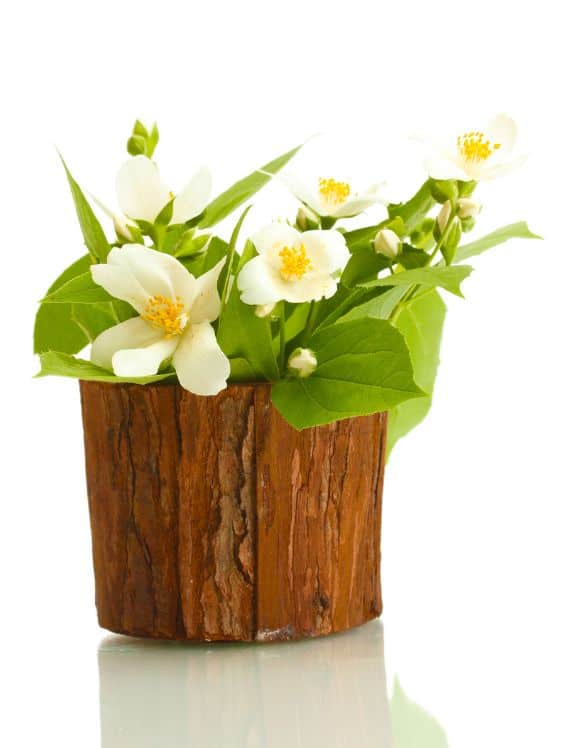
Jasmine makes a great bedroom plant due to its scent having a calming effect.
It needs direct sunlight to grow during the summer. It can have a little less light in the winter, but still likes a lot of light.
It is considered non-toxic for cats, dogs, and humans.
Lavender (Lavandula)

Lavender has been known to help with sleep making it a great choice for a bedroom.
The lavender scent is known to be calming, making it helpful for falling asleep.
The only disadvantage to lavender as a bedroom plant is that it can be difficult to grow indoors. If you decide to try lavender, the smaller varieties, like French Lavender, are easier to grow indoors.
It is considered toxic to cats and dogs and non-toxic to humans.
Golden Pothos (Epipremnum aureum)

Golden pothos, also known as devil’s ivy, is the perfect plant to have on your bedside table. It’s easy to grow and can tolerate most lighting conditions. Though it prefers bright, indirect light and will grow faster in those conditions.
Pothos can clean benzene and formaldehyde from the air making it a great addition to the bedroom.
It is considered toxic to cats, dogs, and humans.
Peace Lily (Spathiphyllum species)
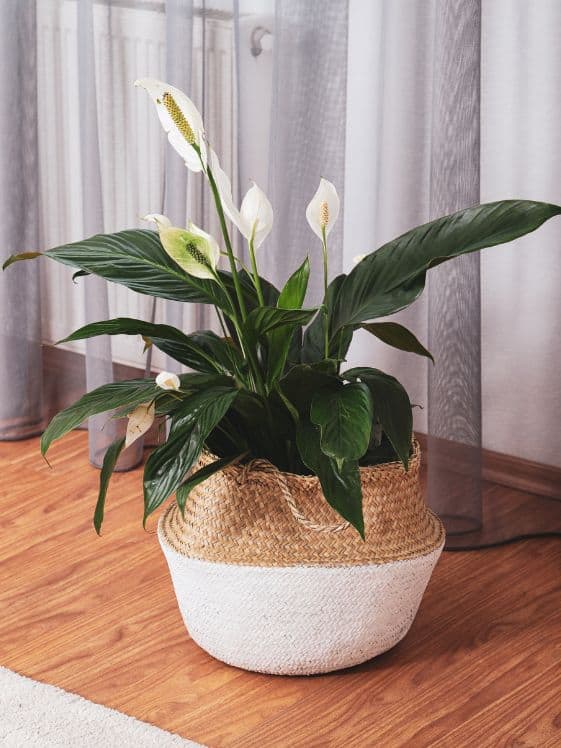
This is another easy-to-grow plant. They like indirect light and high humidity. Misting their leaves helps to keep them humid enough.
They are also good at cleaning the air. They can remove benzene, formaldehyde, and trichloroethylene from the air.
Peace Lilies are considered toxic to cats, dogs, and humans.
Bamboo Palm (Chamaedorea seifrizii)

Bamboo palms like indirect or filtered sunlight. Not enough light can cause the fronds to start dying back. It also likes to be kept moist, but not soggy.
Bamboo palms are another plant that are good at cleaning the air. They can remove benzene, formaldehyde, and trichloroethylene from the air.
It is considered non-toxic to cats, and humans.
Heartleaf Philodendron (Philodendron hederaceum)
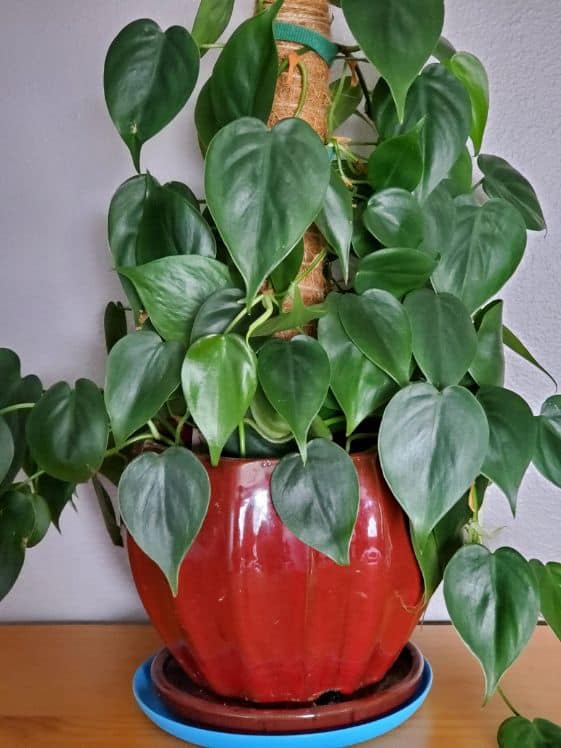
This plant is very easy to grow and has lovely heart-shaped leaves. It does well in medium to bright, indirect light but can tolerate low light.
It likes moist, but not soggy soil during the growing season. In the winter, it prefers the top of the soil to dry out between waterings.
Heartleaf philodendrons are considered toxic to cats, dogs, and humans.
Rubber Plant (Ficus elastica)
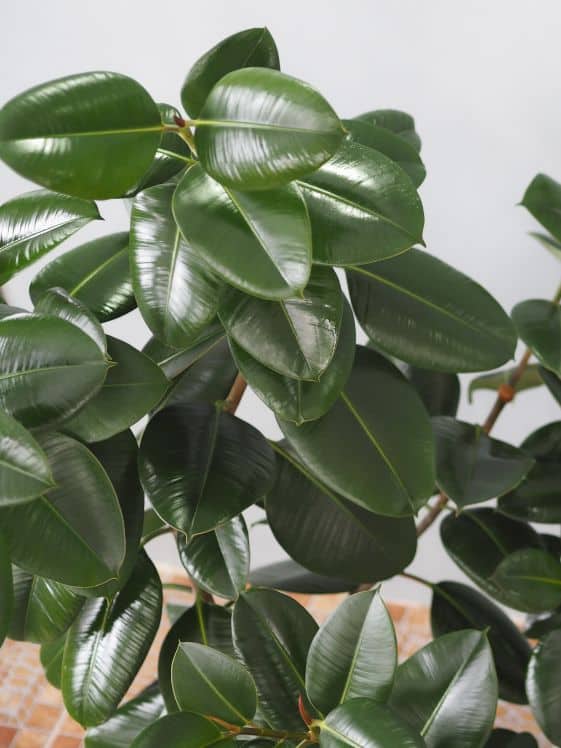
The rubber tree is an easy plant to grow and will grow in low light conditions.
It is a low-maintenance plant that can also clean the air by removing formeldehyde.
They can grow to be larger than you might want in a bedroom, but regular pruning can limit it’s size.
Rubber plants are considered toxic to cats, dogs, and humans.
Areca Palm (Chrysalidocarpus lutescens)
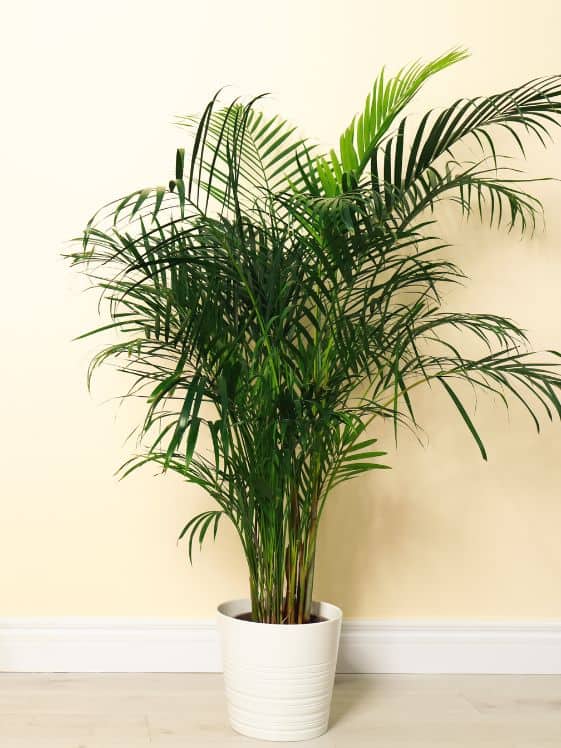
The Areca palm is an easy plant to grow and does well in bright, indirect light. It does not tolerate low light or direct light.
It needs to be kept moist during the growing season, but not soggy. In the winter, it prefers the top of the soil to dry out between waterings.
This palm is great at cleaning the air. It can remove formaldehyde, xylene, and toluene from the air.
It is considered non-toxic to cats, dogs, and humans.
Chinese Evergreen (Aglaonema commutatum)
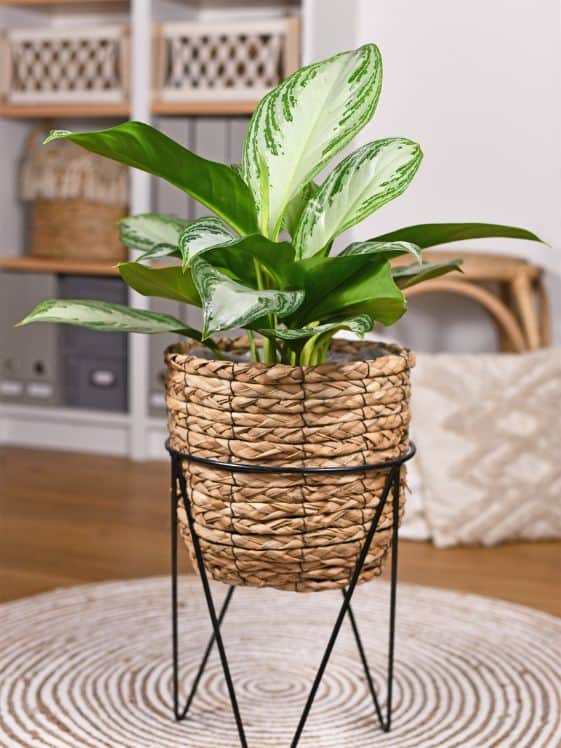
Chinese evergreen is an easy plant to grow and does well in low light conditions. It can tolerate brighter light, up to indirect sunlight. It does not tolerate direct sunlight.
It prefers moist soil, but not wet. Water it before it drys out completely.
But don’t leave it in soggy soil or it will develop root rot.
Chinese evergreens are considered toxic to cats, dogs, and humans.
Gerbera Daisy (Gerbera jamesonii)

Gerbera daisies are a bit more difficult to grow indoors, but they make a great addition to the bedroom. They like bright light, but not direct afternoon sunlight.
They need to be kept moist during the growing season. But prefer to dry out a little between waterings in the winter. Just don’t let it get completely dry.
Gerbera daisies are considered non-toxic to cats, dogs, and humans.
ZZ Plant (Zamioculcas zamiifolia)

ZZ plants are very easy to grow and do well in low-light conditions. They can tolerate bright, indirect light, but do not like direct sunlight.
Water the zz plant when the soil has dried out. The roots have rhizomes that store water, which means it can tolerate less frequent waterings than most plants.
Overwatering a zz plant is more dangerous to the plant than underwatering.
ZZ plants are considered toxic to cats, dogs, and humans.
Parlor Palm (Chamaedorea elegans)

Parlor palms are easy to grow and do well in medium to bright indirect light. Though it can tolerate lower levels of light, it does not tolerate direct light.
It also doesn’t tolerate overwatering. Allow it to dry out between waterings and don’t let it become waterlogged. If it becomes waterlogged it may kill the plant.
Parlor palms are considered non-toxic to cats, dogs, and humans.
Monstera adansonii

The monstera adansonii, also known as the swiss cheese plant, is a little trickier to grow inside than some plants. But it makes a great addition to the bedroom.
They like bright, indirect light and like to be kept moist during the growing season. Though it doesn’t want to be waterlogged.
It also likes to have something to climb, so adding a trellis or moss pole will make the plant happier.
Swiss cheese plants are considered toxic to cats, dogs, and humans.
Boston Fern (Nephrolepsis exaltata)

Boston ferns are another finicky plant, but they are worth the effort. They like bright, indirect light and high humidity.
They also like to be kept moist, but not waterlogged. Check it regularly to make sure it isn’t drying out too much.
Along with not wanting to be waterlogged, Boston ferns don’t like drafts. Keep it away from doors, windows, and heating vents.
Boston ferns are considered non-toxic to cats, dogs, and humans.
Corn Plant (Dracaena fragrans)

Corn plants are an easy to care for plant, especially when the right conditions are met.
They like bright, indirect light but can tolerate lower levels of light. Just keep it out of direct sunlight as it can burn the leaves.
It likes to be kept moist during the growing season but prefers it if you allow the top inch or so of soil to dry out before watering in the winter.
Corn plants are considered toxic to cats and dogs but non-toxic to humans.
Valerian Plant (Valeriana officinalis)
Valerian plants are considered easy to grow and do best in bright, indirect light. It prefers moist soil but doesn’t want to be soggy.
One note on valerian if you have cats. Cats are drawn to the scent of valerian and may cause damage to the plant. Keep this in mind when deciding on where to put the plant if there are cats in your house.
Valerian plants are considered non-toxic to cats, dogs, and humans.
Monstera deliciosa

Monstera deliciosas are a beautiful plant that will become quite large if the conditions are right.
They prefer bright, indirect light though they will survive in lower light. I say survive, because their growth is affected by lower light conditions.
Monsteras are known for their leaf fenestrations (the holes in the leaves) but they only produce these holes if they get enough light.
These plants prefer a thorough watering, but don’t like to be soggy. Drain off any excess water and allow the top inch of soil to dry before watering again.
They also prefer to have something to climb, like a moss pole. Without it, a monstera may start to grow in weird dirctions.
Monstera deliciosa is considered toxic to cats, dogs, and humans.
Benefits of Having Plants in Your Bedroom
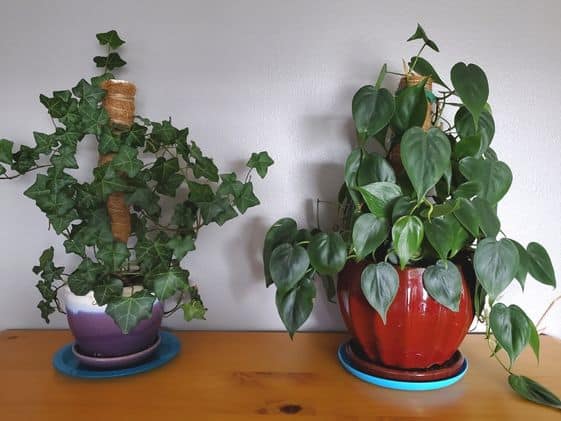
There are many benefits of adding plants to your bedroom. Some of these benefits include:
Calms the Mind
Studies have shown that being around plants can help to reduce stress levels. This could be from having a piece of nature in your home.
Or it could be from the calming effect some people get when they care for their houseplants.
Either way, some people feel calmer and more peaceful when they have plants in their home.
Can Aid Sleep
The presence of plants in the bedroom has been shown to improve sleep quality. This could be due to the fact that some plants have a calming scent. This is especially true for plants like lavender.
It could also be due to the act of watering and caring for your plants having a soothing effect. Both of these factors combined can lead to better sleep.
If you have trouble sleeping, try adding a plant or two to your room and see if it makes a
Regulates Humidity
Plants help to regulate humidity levels in the room by releasing water vapor into the air. This can be beneficial in the winter when the air is dryer due to indoor heating.
It can also help to keep your skin from drying out as much and becoming irritated.
Improved Air Quality
According to NASA’s clean air study, plants help to filter the air and remove harmful toxins. This can lead to improved air quality and fewer respiratory problems.
There is some debate on whether or not the results from the NASA study can be applied to a home setting, but that is for scientists to decide. I will have plants in my home whether they actually improve air quality or not.
Final Thoughts
Ultimately, there isn’t one best plant for your bedroom. It depends on your specific needs and preferences.
Do some research on the different plants, starting with those above, and find one that will work well in your space and with your lifestyle.
Once you have your plant, take care of it and enjoy the benefits it brings to your life.
Related Posts
27 Types of Pothos to Grow in Your Home
